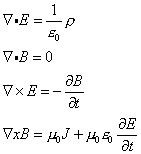
Maxwell and Electromagnetism
Back to the main page
If we are to understand light we must first understand electricity, although on the surface it is hard to see the connection. The creation of light is an electrical process and its propagation is an electromagnetic one.
The history of man's curiosity with electricity goes back as far as Thales of Miletus in 600 BCE, who experimented with the attractive effect rubbing various materials together had, i.e. rubbing amber (elektron in Greek) with other materials caused it to attract light objects. It became clear that there were two kinds of electricity, vitreous (caused by rubbing glass, among other materials), and resinous (caused by rubbing amber and resins, among others). At first it seemed that electricity was a property of the material exhibiting electrical effects, but the movement of electricity along wires led to the idea of an electrical fluid, or more correctly, two fluids (one vitreous; one resinous) that flowed from place to place. Benjamin Franklin became interested in the matter while in Europe and on his return to the Americas began a series of investigations using a single fluid theory (being unaware of the two theory model popular in Europe). In his theory all objects had a normal amount of electricity: If some were taken away the object took on the electrical property of being depleted of electric fluid (it became negatively charged). If extra fluid was added it became positively charged. (We owe the arbitrary assignment of the names positive and negative electricity to Mr. Franklin). As the study of electricity flourished, so did the study of magnetism, and it was first noted by Hans Christian Oersted that a current flowing in a wire near a magnet caused the magnet to move. From this Andre-Marie Ampere and Michael Faraday developed theories linking the fields of electricity and magnetism.
| The crowning achievement was accomplished by James Clerk Maxwell who, by combining the work of Faraday and Ampere with his own results, was able to unify the two fields of electricity and magnetism into a single electromagnetic theory, described by only a few equations. These equations, in a somewhat more modern form than Maxwell's original, are shown on the right. It is not necessary that you know or understand these equations, but contained in them are interesting stories, and one in particular. The first equation is called Gauss' law. In it E is the electric field of Faraday, D (the Greek character rho) represents electrical charge, and the proportionality constant between these two (,0) is called the permittivity of empty space. This constant takes its value from the character of the medium in which the electromagnetic wave finds itself - for these equations, the vacuum of empty space. The second equation has its roots in the fact that magnets never have a single pole - if you cut a magnet in two the north and south poles are not isolated; they form new magnets, each complete with their own north and south poles. The third equation is really Faraday's law. It relates a changing magnetic field (B) and the electric field (E). The forth equation is a form of Ampere's law, modified by Maxwell. It, somewhat the opposite of the third equation, relates a changing electric field (E) and the magnetic field (B). In this equation is the same permittivity (,0) of the first equation and a second constant (:0), called the permeability of free space. It is in these two constants (,0 and :0) that the story I mention above lies: Maxwell noticed that when the electric and magnetic fields were arranged to describe how these fields propagate through space, the constants appeared in a form that represented a velocity, and that velocity had a numerical value of 3x108 meters per second. This number should be familiar to you - it is the velocity of light! In this one moment Maxwell answered the first question of the previous section: What is light? It is an electromagnetic wave! Other than the frequency of its oscillation it is identical to a radio wave, or an x-ray or the radiant heat from the sun, or a television signal. They are all the same, save the rate at which they oscillate - electromagnetic waves. |  |
We now need to answer the third question: Where does light come from? To answer this we need to look into the very structure of matter. A historical picture of how our knowledge in this matter grew is instructive: